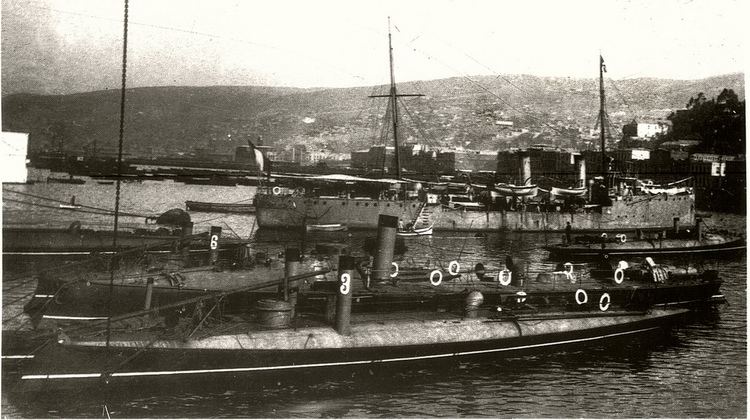 | ||
The introduction of fast torpedo boats in the late 19th century was a serious concern to navies of an era that saw a number of innovations in naval warfare, including the first torpedo boats, which carried spar torpedoes, steam propulsion and steel ships.
Contents
- Chilean torpedo boats
- Torpedo boat Vedette
- Torpedo boats built 1879
- Torpedo boats built 188082
- Peruvian torpedo boats
- References
Clements Robert Markham, later president of the Royal Geographical Society, an English eye witness of the War of the Pacific stated:
The value of fast torpedo boats in maintaining a blockade cannot be over-estimated. They are not only the "eyes" but the "legs" of a squadron. Not only are they of use in preventing the escape of any of the enemy's ships, but they also afford protection to their own fleet, giving timely notice of approaching danger at night by a prearranged system of flashing lights, and in the daytime by their great speed. The thoroughness of the blockade of Callao was undoubtedly due, in a great measure, to the Chilean torpedo boats.Chilean torpedo boats
With the exception of Vedette, all boat names are of Mapudungun procedence.
Torpedo boat Vedette
The Vedette was built in Yarrow of Poplar (Yard nr. 495) and arrived to Valparaíso on 17 October 1879 on board of the Belle of Cork. She was assembled in Valparaíso and in 1893 she was still listed by the navy. The name seems to be the name of the boat class rather than the proper name of a boat.
Torpedo boats built 1879
Yet 1880 were delivered to Chile two torpedo boats bought from Yarrow of Poplar shipyard., the Colo Colo (Yard nr. 476) and the Tucapel:
They could be stowed in the mayor ships of the navy and the Colo Colo was brought by Railway to Puno and then to the Titicaca Lake (elevation of 3,812 metres (12,507 ft)) in order to impede guerrilla activities in the zone.
Torpedo boats built 1880–82
During the War of the Pacific the Chilean Navy bought ten Torpedo boats from the Yarrow of Poplar shipyard.
Peruvian torpedo boats
1879 the Peruvian Government bought three torpedo boats: Alay, Alianza and República from the Herreshoff Manufacturing Company, Bristol, Rhode Island, United States, although R.V Simpson states that the third boat was never delivered to Perú.
Alianza and República arrived to Perú in August and September 1879. Both boats were scuttled (Alianza in June 1880 and República in January 1881) to prevent their capture by the Chilean forces.
The Alay was transported per ship to Colon, Panama, at the Caribbean Sea. From Colon she was transported by rail to Panama City, at the Pacific Ocean. On 2 December Alay could sail bound for Perú but on 24 December the Chilean transporter Amazonas captured the boat in the Ecuadorian port Ballenita. In Chile she was renamed Guacolda and commissioned to the navy.
